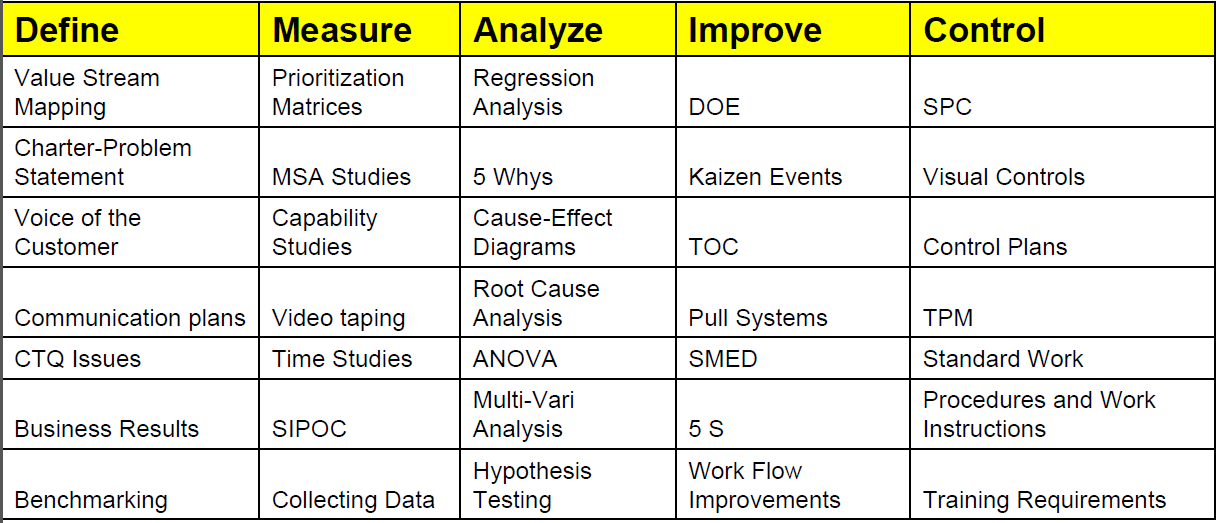Lean vs Six Sigma
Lean vs Six SigmaLean Six Sigma Benefit Comparison of Six Sigma and Lean Six Sigma : When to execute Lean six sigma Reduce variation / Lean : Reduce Waste Six Sigma : Six Sigma Quality (3.4 DPMO) / Lean : Speed (velocity) Six Sigma : Cost of Poor Quality / Lean : Operating Costs Six Sigma: Long / Lean : Short Six Sigma: Various approaches / Lean : Value Stream Mapping
Six Sigma Benefit
Eliminate Variability & Improve Quality
•Data Collection/Measure Analysis
•DMAIC Project Flowchart
•Tie Project to Business Metrics
Lean Benefit
Identify & Eliminate Process Waste
•Improve Process Flow and Efficiency
•Develop low cost, simple, agile processes
Comparison of Six Sigma and Lean
Improvement
Six Sigma : Reduce variation / Lean : Reduce Waste
Justification
Six Sigma : Six Sigma Quality (3.4 DPMO) / Lean : Speed (velocity)
Main Saving
Six Sigma : Cost of Poor Quality / Lean : Operating Costs
Learning Curve
Six Sigma: Long / Lean : Short
Project Selection
Six Sigma: Various approaches / Lean : Value Stream Mapping
Project Length
Six Sigma : 2-6 Month / Lean : 1 week -3 month
Driver Data Demand
Six Sigma: Complexity / Lean : High Moderate
When to execute Lean
If major business problems are:
•There seems to be a lot of wastes
•There is a need to minimize inventories and redundancies
•There is a need to improve work flows
•There is a need to speed p processes
•There are human mistakes
Then, Lean techniques can be used to:
•Eliminate wastes
•Simplify processes
•Increase speed
•Improve flows
•Minimize inventories
•Mistake proof processes
When to execute Six Sigma
If major business problems are:
•There are quality issues
•There is excessive variation
•There are complex problems
•There are challenging root cause identifications
•There are numerous technical considerations
Then, Six Sigma techniques can be used to:
•Minimize variation
•Apply scientific problem solving
•Utilize robust project chartering
•Focus on quality issues
•Employ technical methodologies
Six Sigma Benefit
Eliminate Variability & Improve Quality
•Data Collection/Measure Analysis
•DMAIC Project Flowchart
•Tie Project to Business Metrics
Lean Benefit
Identify & Eliminate Process Waste
•Improve Process Flow and Efficiency
•Develop low cost, simple, agile processes
Comparison of Six Sigma and Lean
Improvement
Six Sigma : Reduce variation / Lean : Reduce Waste
Justification
Six Sigma : Six Sigma Quality (3.4 DPMO) / Lean : Speed (velocity)
Main Saving
Six Sigma : Cost of Poor Quality / Lean : Operating Costs
Learning Curve
Six Sigma: Long / Lean : Short
Project Selection
Six Sigma: Various approaches / Lean : Value Stream Mapping
Project Length
Six Sigma : 2-6 Month / Lean : 1 week -3 month
Driver Data Demand
Six Sigma: Complexity / Lean : High Moderate
When to execute Lean
If major business problems are:
•There seems to be a lot of wastes
•There is a need to minimize inventories and redundancies
•There is a need to improve work flows
•There is a need to speed p processes
•There are human mistakes
Then, Lean techniques can be used to:
•Eliminate wastes
•Simplify processes
•Increase speed
•Improve flows
•Minimize inventories
•Mistake proof processes
When to execute Six Sigma
If major business problems are:
•There are quality issues
•There is excessive variation
•There are complex problems
•There are challenging root cause identifications
•There are numerous technical considerations
Then, Six Sigma techniques can be used to:
•Minimize variation
•Apply scientific problem solving
•Utilize robust project chartering
•Focus on quality issues
•Employ technical methodologies
